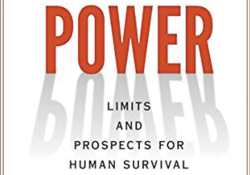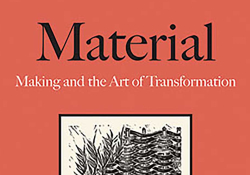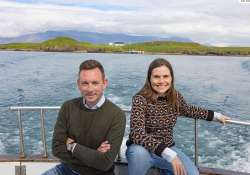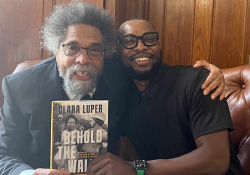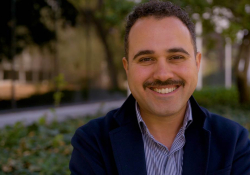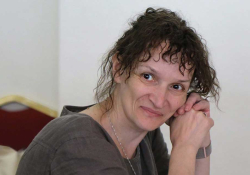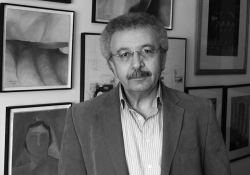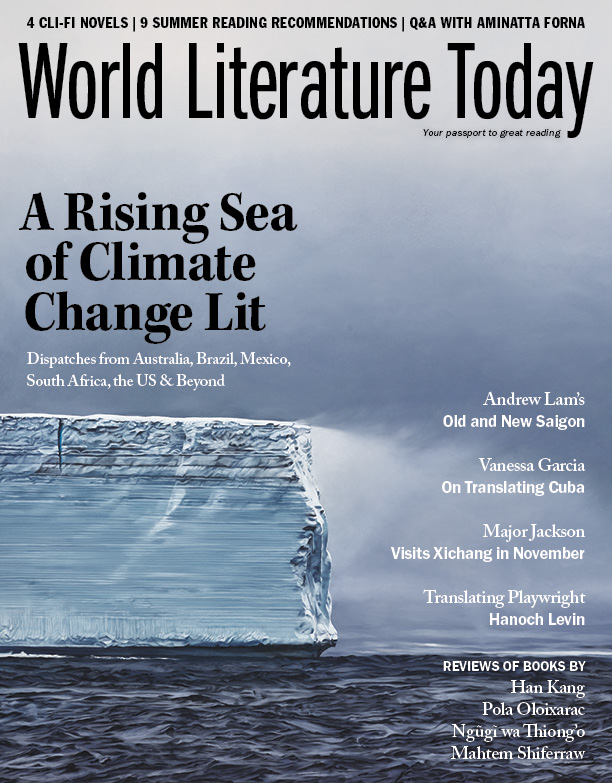Shouting for Less: A Conversation with David Holmgren

David Holmgren is an environmental designer, writer, and co-creator of the permaculture concept, which uses systems theory to create by design the resiliency found in natural systems. He is the author of several key texts associated with the sustainable-living movement, including Permaculture: Principles and Pathways Beyond Sustainability (Holmgren Design, 2002), Future Scenarios (Chelsea Green, 2009), and, most recently, RetroSuburbia: The Downshifter’s Guide to a Resilient Future. He lives with his partner, Su Dennett, in Central Victoria at Melliodora, Hepburn Springs, where they have conducted research in the lived permaculture experience for more than thirty years.
Rob Vollmar: The National Oceanic and Atmospheric Administration here in the United States announced recently that 2018 was the fourth hottest year on record, which completes a trend to make the last five years the hottest five in recorded human history. Your focus as a designer and a writer is very localized to where you live. How are those elevated temperatures expressing there in Central Victoria and, more broadly, across the landscapes of Australia?
David Holmgren: Rains come in our Mediterranean climate primarily in the winter and the spring, and then, historically, the rain breaks out in the autumn after a long pause in the summer. That was a critical factor for broadacre pastoral farming in Australia. We had a name for it, the autumn break. I started saying twenty years ago, “What is this autumn break?” I’ve lived in Central Victoria for a decade and haven’t seen one. So, that shift has been significant for a long time. The more general prediction of the drying of the climate, of less rain, especially of less rain in winter and spring, has been evident. The thing that used to frustrate me most about climate predictions is that there would always be this footnote about extreme weather events. Because there was great difficulty in modeling that, scientists tended to focus on the predicted average temperature increases. I saw that these more extreme events were the critical thing that would tip over ecosystems, agriculture, and infrastructure.
We’ve been seeing that, but it’s much harder to measure those things—greater intensity of some storms, greater heat waves—and, in our part of the world, what goes with that is increased intensity and risk of bushfire. Bushfire, being in the most fire-vulnerable region of the world, has been the greatest expression of a warming climate. The general desiccation of the landscape has produced another renewed crisis in our greatest river system, the Murray-Darling system, with massive fish-kills and a huge debate that is underlining the failure of governance, between national and state governments, and corruption involving the growing of cotton on the driest continent on the planet. These things are becoming front-page news more and more often.
Our experience here in Central Victoria is that we just went through a January where not only the maximum temperature but the overnight minimum temperatures were the hottest by far we’ve ever experienced. Being small-scale horticulturalists, the amount of water we’ve used in that time has been quite shocking. This has been the shared experience of all the people in our area. The rainfall has been low and we’ve had very high open-pan evaporation figures, which tells us the water demand. So, it’s a whole sequence of things. These kind of events come and go, but there have been records broken right across Australia this last year, and that’s been a pattern now; the hottest years of the century were all clustered in the past ten years.
Vollmar: I’ve been reading up recently on the Dust Bowl in the United States. There is a kind of irony in the contrast between that ecological crisis and the one we’re facing now. When you’ve gone out, in living memory, and plowed up the prairie then left it uncovered, and then the winds come and pull immense amounts of soil up into the air and buries everybody and kills people in these dust storms, there’s no confusion about the causality between those two events. But with our modern extreme-weather events, whether it’s a really active hurricane or tornado season, with each new precedent that gets set, even people who agree that climate change is very serious, we look at each other, asking, “Is this what climate change looks like?” There’s not that explicit tie, and, if there were, people who consider themselves to be climate-change skeptics or deniers might be more easily swayed from that position because they live in places that are being directly affected by the extreme-weather events. Without that causal link, it’s easy enough to say, “Yes, the river is flooding, but that’s got nothing to do with climate change.”
Holmgren: I think there are all sorts of different coping strategies that people have with information that is challenging to their worldview. Certainly, what’s generally called denial is one of them. This often shows up in highly intelligent people, who have some complex rationalization. My work in permaculture has been focused on the positive reasons for a change to a better way of living, which is very difficult to project in a world where humanity has just chewed its way through the greatest nonrenewable resource stocks in a very short time. Contemplating the idea of mass movements in history shouting, “Less!”—there’s not much evidence of those.
My permaculture work, especially as directed to the billion, perhaps a billion and a half, middle-class people on the planet, as opposed to the people at the other end of the spectrum, has been about constructing the notion of a world where less material and energy consumption is not just better for the future but better for us now. That is a complex, inwardly focused, and older message about voluntary simplicity that comes to us from many spiritual traditions but is also tethered to ideas like smart ecological design and how to get off the treadmill of how we provide for our needs at the moment. Do it in simpler and smarter ways. Those messages don’t require that you even need to believe in climate change to be valid. For all the different groups in society, the worldview constrains and filters what type of information people respond to.
My permaculture work has been about constructing the notion of a world where less material and energy consumption is not just better for the future but better for us now.
Vollmar: There is a sense of urgency binding all the different strains of permaculture and sustainable-living practices together that has its roots in Limits to Growth and the predicted energy-descent future. How early did that become a central concern of yours, and how has your conception of an energy-descent future changed over time?
Holmgren: Permaculture, from the beginning and through its teaching, has always been informed by a dire view of the state of the world. The Limits to Growth report, which I believe to be the most important scientific report in history, was very influential. I met Bill Mollison two years after its publication in 1972; our close working relationship in the mid-1970s led to the publication of Permaculture One (1978). So, the oil crises of 1973 and 1979 bracketed the emergence of permaculture, and it was those oil crises that brought the broader public focus on the limits to growth. Particularly on the limits to resources side, though the limits to growth also have a limits of sinks side—i.e., where you send all the pollution. Peak oil, the constraint of the world’s most important nonrenewable resource, is emblematic of the limits of resources, and climate change is emblematic of the limits of sinks.
Peak oil, the constraint of the world’s most important nonrenewable resource, is emblematic of the limits of resources, and climate change is emblematic of the limits of sinks.
Climate change didn’t come to the fore until the second great wave of modern environmental thinking and activism in the late 1980s and early 1990s with the formation of the Intergovernmental Panel on Climate Change (IPCC) in 1988. There was also a second wave of interest in permaculture at that time. When I met Bill Mollison back in the 1970s, there were certainly people in his circle who were quite catastrophist or survivalist in their attitudes and responses to imminent collapse. I saw a lot of people working through trying to understand how modern industrial society might unravel. A lot of the early thinking about that can now be looked back on as quite naïve, but it also created a lot of the building blocks for thinking about a world of energy descent. Some of my generation decided, for example, “I want to learn how to be a blacksmith because, after the collapse of industrial civilization, we’ll need to know basic, old-school metallurgy.” This is one of the reasons that we have blacksmiths today, because the older generation who had those skills in many regions of the modern world were dying out. Apart from horse farrying, the art of blacksmithing was disappearing. So this conservation of old skills is part of a legacy from those back-to-the-land, self-sufficiency, do-it-yourself activities that were partly informed by lifestyle choice and partly informed by a sense of necessity, whether in the short or the long term.
Over those decades, my understandings and perceptions about what I came to call the energy-descent future, rather than a collapse future, have been a very important part of my work. I emphasize how the history of past civilizations suggests we face crises that feel like collapses, followed by stabilizations and reorganizations of society at a lower level of complexity, discarding some things that society was starting to do rather than constantly expecting to do more and more complex things on top of all the things we’ve always done; a longer historical process of change, rather than some immediate event. From some perspectives we’re many decades into that energy-descent process, while the dominant paradigm is still the one I was fed by boys’ magazines when I was a child in the 1950s that I would have holidays to Mars and my own personal rocket pack.

I emphasize how the history of past civilizations suggests we face crises that feel like collapses, followed by stabilizations and reorganizations of society at a lower level of complexity.
Vollmar: In your book Future Scenarios, you zero in on climate change and peak oil as the key variables in projecting these four visions of the future. How will the intersection of those two particular crises define the future of the human race?
Holmgren: Amongst all the huge factors that are challenging the business-as-usual growth of industrial society, the two primary drivers, which show up in many other different forms—geopolitical stress, financial system instability, and the risk of pandemics—are peak oil and climate change. There was uncertainty in both. There was great uncertainty about when the world would peak in production of conventional oil, which is a significantly different resource than the unconventional oil now being extracted, a resource with much lower net energy. The uncertainty was not so much about when the peak would be but what the rate of decline postpeak would look like. Whether it would be relatively gentle, allowing for some sort of structural adaptation to less net energy available to society, or whether it would be more precipitous and pull apart and fundamentally damage the structures of industrial society.
That, then, is overlaid on a different axis with uncertainties about climate change. While I’ve never been a skeptic about the process of climate change, I’ve been a radical skeptic about the uncertainties of the rate and the severity of the unfolding of climate change from the complexity of the models. What we’re seeing by the evidence is that most of the models and certainly the IPCC forecasts have been way too conservative. Will the onset of climate change be relatively slow and relatively benign in its effects, or will it be quite fast and catastrophic in its effects in a relative sense?
That creates four spaces. The most benign one I call Green Tech, though not in the sense that most people would use the term. It’s a world of contraction but one where the wealth shifts to being derived from more distributed forms of energy like solar and wind. That means wealth shifts back to hinterlands and places where those sources of energy are, which follows the old pattern that existed before industrialization. Before we got our primary power out of “holes in the ground” and concentrated it in our cities, we got it from farms and forestry, which are distributed across the landscape. That suggested a world where farming, forestry, and renewable energy would become bigger parts of the economy. There would be a lot of structural adjustment that might further encourage low-carbon strategies, which would further feed back into reducing the severity of climate change and further contract the dependence on oil. This scenario moves, at least for some period, into a stable state.
The next scenario I looked at I call Brown Tech, where the oil decline postpeak is relatively slow again but climate crisis onset is quite severe. Because that expresses itself through crisis, like tornadoes, hurricanes, and bushfires, government is forced to respond and rediscovers its role in a command rather than a market economy. The same way that even in the United States during World War II, the market economy was shunted aside in favor of a command economy under Roosevelt. So we know that, even in these places where there is an ideological commitment to markets, when the crisis is big enough, people wake up and say, “We’re the government and we’ve got to do something.”
A lot of the things that get done, though, end up feeding back into more greenhouse gas emissions. Like the desalination plants built in Australia over the last decade, which all use huge amounts of energy. Building massive sea walls to protect cities from rising sea levels would be another example. These examples demonstrate a hardening and armoring of the core of the infrastructure system while the outer fingers of the system are abandoned. So in our context, here in Central Victoria, we know that single-line, earth-return power lines, which are the cause of the bushfires, need to be put underground, but it’s too expensive. At some point, the government is likely to close down those lines and say, “Sorry. You’re on your own. No electric power in the regions.” Or, “You can move to the cities, here’s cents on the dollar for your now valueless rural property.”
There are lots of scenarios where the system actually concentrates in a geographic way with its support of the urban centers but also in a conceptual sense: the system goes through a sort of schizoid process where it wants people to become more self-reliant and less dependent on government, as government invests more into these massive remedial systems in a contracting economy. It’s pushing people off welfare, pushing people to look after themselves, but those centralized systems, like the industrial, monopolized food system, need everyone shopping at a supermarket for viability. There’s this tension between the feral food economy like farmers’ markets and grow-your-own and the central food system. One arm of government and corporations is trying to squash those things, and another part is trying to encourage people to be self-reliant so the system doesn’t have to support them.
I’m suggesting that those dynamics of policies and behavior don’t primarily come from people being bastards or the result of evil corporations. They are a dynamic response to these primary drivers. The positive thing about Brown Tech is that there are still enough resources for society to meet its basic needs if it got its act together and reorganized, even though it is contracting. Most of our economy is discretionary. It’s not really necessary. The dog shampoo services and the gymnasia for people to keep fit. None of those things are necessary. In theory, we could close down three-quarters of the economy and still be providing for basic needs.
My other two scenarios of Earth Steward and Lifeboat are both more serious, because the rate of oil supply, which sustains 90 percent of transport, falls something like 10 percent per annum. So far, postpeak of conventional oil, we haven’t had that rate of fall, and those scenarios look, with more than a decade’s further knowledge, less likely though they are still possibilities. The difference between the Lifeboat and Earth Steward scenarios is that, in the Earth Steward scenario, the collapse of the world economy switches off the carbon dioxide emissions to a large degree. We’re saved from the worst effects of climate change, though we go through a massive crisis that reengages people with a nature that is still working. We are saved by nature. Even an earth-centered spirituality revival emerges. The Lifeboat scenario features the same industrial collapse, but we’re so far down the track with climate change tipping points that we end up in the climate cooker anyway. That’s the most extreme of my scenarios, but I still see them all as energy descent.
I’ll give just one more example of that more extreme scenario. In that, rather than a return to the Stone Age, people will be left in a salvage economy where the discards of industrial society are lying around everywhere. Functioning engines that can run on any sort of leftover oil or biomass will be so abundant that, for those who can actually make use of them, they are effectively a free resource. The production of food each year and the security of the community might be urgent and serious concerns, but there is this enormous material abundance. With the collapse of world trade, shipping containers become default new building stock. Why would we ever build any more buildings? We’ll have more buildings than we could ever possibly use. Even in those very severe scenarios, many factors are emergent and novel, including opportunities that people haven’t faced before, but we can relate it to the historic precedent of what the monasteries did in the period after the collapse of Rome: saving the elements of civilization and being able to do that because they were self-reliant, mostly rural communities and because they supported their constituent surrounding communities with critical agricultural and engineering knowledge. Those communities protected the monasteries, and the monasteries were able to do their core work of salvaging the knowledge of the civilization that was fading.
Even in those very severe scenarios, many factors are emergent and novel, including opportunities that people haven’t faced before, but we can relate it to the historic precedent of what the monasteries did in the period after the collapse of Rome.
A lot of people would say, “Well, that’s a severe scenario.” I see those now as much more likely to emerge after some longer period within the Green Tech or Brown Tech scenarios. Stepwise, if we’re in a Green Tech scenario, there could be a more gentle segue into an Earth Steward scenario with a benign climate. Unfortunately, the Brown Tech world tends to armor itself and will drive a more precipitous collapse into the Lifeboat scenario. It’s a complex view, but it’s very hard to offer these nuanced views of the future and how different they could be when we’ve tended to have these road-rage movies like the Australian Mad Max films as an intellectual reference point for dystopias. It is pleasing to see that popular culture is coming up with some, at least a bit, more sophisticated dystopias for our imaginations to work with these days. It’s still an area where there’s been very little serious intellectual consideration of energy-descent futures.
Vollmar: Recently, a volume of solarpunk fiction out of Brazil was translated into English from the Portuguese. A film like Mad Max is going to be better at expressing our deepest fears about how a collapse might look, but as that energy-descent future gets closer, literary responses to those concerns sharpen in their focus. As we can more clearly see likely paths sitting in front of us, the question becomes, Can we creatively imagine something in that space other than people in a lake of fire screaming for eternity or whatever other conceptions of apocalypse we may culturally bring to the table? Even in periods of collapse, people have to live their lives. We have to continue to be a part of nature, as we’ve always been, even though nature has entered into a state for which we have no historical precedent.
Holmgren: It’s important to understand that periods of extreme crisis, especially ones that are destructive, only go on for a very short time, and then some new scenario emerges. A lot of thinking about the future focuses on imagined crises but doesn’t ask, “What is the world that emerges after those crises?” In Future Scenarios workshops, the emphasis is not on the details of that fall off of the cliff face but the mountain ledge plateau that one ends up waking up on after the fall. Things do stabilize even if then there is another future crisis, creating this sort of stepwise energy-descent future. Human adaptability to whatever becomes one’s daily experience eventually becomes a learnt normality, especially for children. People will grow up with a completely different perception of what is normal. In doing Future Scenarios workshops, especially with environmental activists, I was very cautious about this work because it’s a shift away from the focus on the positive solutions, getting people involved in permaculture and positive solutions—a bit of an over-the-horizon view. I found people sometimes reported that they were enormously empowered by the experience. I thought, “Gee. What were the scenarios in their heads?”
This inability to publicly talk, about futures other than the arrow-of-progress of modernity has meant that people’s own private conceptions become darker because it’s not discussed. There is value in that discussion. The other side of the equation is that more and more people can see that the arrow-of-progress is looking darker itself. The techno-optimists that advocate hybridizing humanity with silicon technology to create new emergent life-forms has many people asking, “Is that really what we want to do?” If we look at it from an energetic and ecological point of view, if the system is capable of harvesting more high-quality energy, then nothing will stop our complete hybridization into machines and the algorithm. This means humans dying out as any sort of autonomous form that our traditional notions of value would consider to be of any value.
There are very dark outcomes that result from society magically having energy and resources to push back the climate and other problems and launch itself onward and upward. That’s something people don’t often consider. Most people would like everything to remain in a steady state. That seems to me to be the least likely future.
March 2019

